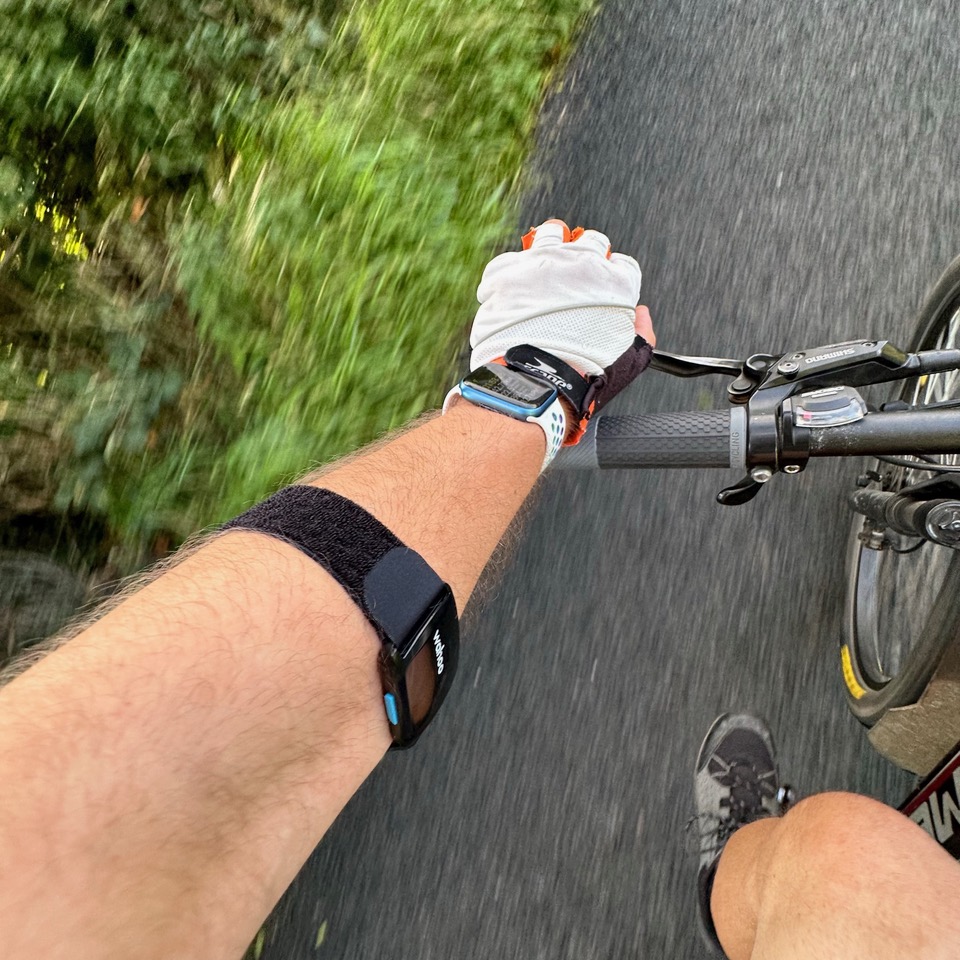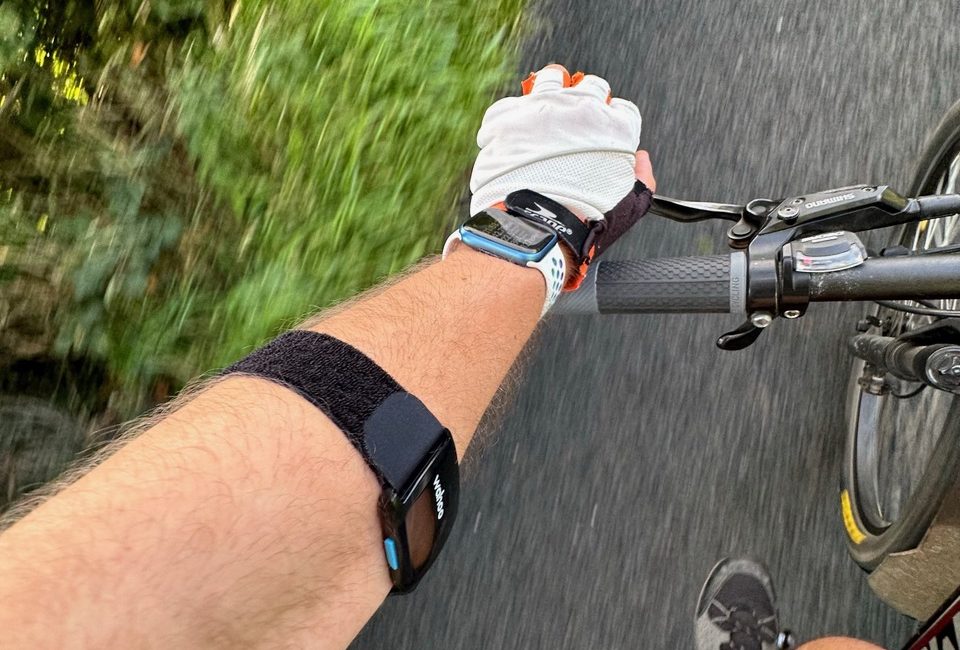The Problem to be Solved
In theory, when everything is working well, when you use the Apple Watch to track a workout it will take regular heart rate readings, display them, and use them to calculate your calorie burn accurately. But to balance battery life and accuracy, the frequency of the checks is tuned for each workout type. Longer-lasting workouts like cycling and hiking take heart rate readings less often than shorter workout types like running.
I’m a cyclist, so I really care about how the watch handles cycling workouts. When the watch succeeds in recording the heart rate, the measurement frequency is fine. Not great, but fine. If you pay attention, you’ll notice that when you change your exertion for a sprint or a big hill, the heart rate shown on the watch stays put for a few minutes and then jumps instantaneously to a much higher rate. That’s not ideal, but it never bothered me enough to spur me on to do something about it.
Where things intermittently break down for me is the assumption that the watch will be able to take accurate measurements while cycling. Sometimes it breaks down explicitly and shows that it’s failed by first greying out a stale value, and eventually replacing it with two dashes. When I see that happen, I can often get it back on track by adjusting the watch on my wrist.
Sometimes it does something much worse though. It makes obviously nonsense measurements but thinks they’re correct! On a very bumpy road, that sometimes means impossibly high rates like 240BPM, but more often, impossibly low values like 72BPM when barrelling along at full speed. As best as I can tell, these errors tend to be by factors of a half, two-thirds, one and a half, or double. My normal cycling heart rate is about 105 to 140 bpm, so 72 is about half, and 240 is about double. I also often see 180 which is about one and a half, and the 80s which is about two-thirds.
I find the tracking is very reliable when walking, as long as I use a good band (not a solo loop!), so I put it down to the harsh conditions the poor watch has to deal with when cycling.
Firstly, my wrist is a crowded place when cycling, especially in winter or in the rain. There’s the Velcro strap for adjusting my mitts/gloves, then the watch, and then often the cuff of a long-sleeved jersey or jacket. If the glove works its way under the watch’s edge, it can lift up and break the skin contact. The same can happen on the other side with the sleeve cuff, or if I get very unlucky, both at once!
Secondly, even when nothing is lifting an edge, the physics are bad. My wrist is rarely perfectly straight while cycling, so the bend in my wrist tends to lift the middle of the watch a little, my wrist is exposed to cold wind encouraging my blood to retreat back into my core — and there’s often rain running over my wrist (when it’s too warm for waterproofs but still raining). Then, of course, there are vibrations — a well-inflated tyre on a rough road can set the watch jiggling to a terrifying degree! When you put all that together you start to realise it’s actually a miracle it ever takes good readings at all!
So, what I needed was an external heart rate monitor that works with the watch and can take more regular and more accurate readings than the watch itself can.
I should have addressed this problem YEARS ago, but my fear of such devices being fiddly and adding faffing about to my routine discouraged me, and the overwhelming array of options stopped me in my tracks!
The Monitor Types to Consider
The first choice you have to make is the type of monitor you want. There exist external wrist monitors, which I guess make sense for people who don’t have a smartwatch, or don’t want to use it as the tracker, but that made no sense for me, so I could eliminate those.
For years everyone seemed to be recommending chest straps as the only option to consider if you want accuracy. That always struck me as a lot of faffing about, especially in winter when I have to wear a lot of layers, so that put me off the idea.
Lately though, I’ve noticed good reviews of trackers that sit on the underside of the lower arm near the elbow. This is an accessible location, and being at the elbow, it seemed likely there would be much less vibrations, and indeed that proved to be the case. There’s also a lot more flesh between your skin and your bone on your lower arm when compared to your wrist, so I assume there’s more blood to see, and, a snug fit should be less uncomfortable, which also proved to be true.
There are also monitors for the upper arm, but in my experience with anything strapped on up there, it doesn’t tend to stay put for me because I seem to flex my biceps too much, and/or they’re too big (let me have my delusions.)
So, a lower arm strap seemed the best option, at least for me.
Connectivity Options
There are standard Bluetooth APIs for health devices, so if you pick a monitor with good support for the Bluetooth standard you should be able to avoid the need for a third-party app. Basically, it should just work with any device that supports Bluetooth health devices, and that includes things like the Apple Watch, iPhone, and Apple TV.
There is also an Apple-specific API called GymKit for connecting to compatible gym equipment, but I don’t use gyms, so I didn’t factor that into my decision at all.
I was ruthless in this criteria — implement the Bluetooth standard or get off my shortlist!
Other Requirements
So far my list of requirements is short:
- Lower-arm strap
- Bluetooth compatible (definitely no required app)
What else was I looking for?
- High measurement rate — at the very least I should get readings as regularly as the watch gives, but if I’m gonna pay for dedicated devices, it really should do better!
- Decent battery life — at the very least it needs to comfortably last a full day on the bike, so it can handle a summer road trip, and ideally it should last a full week of normal 2-3 hours of daily use, so at least 8 hours, ideally 21.
I guess I should also add that I was cranky enough and expected to get enough use out of the tracker to justify spending €100 to €200, so that was my budget.
My Choice — The Wahoo Tickr Fit
eu.wahoofitness.com/… (€80)
Firstly — my budget was overly high, turns out I could get a near-perfect device for my needs for just €80!
So what does the Wahoo give me?
- Lower-arm strap with two different lengths included (it’s really secure and comfy!)
- Near-continuous data flow — the lag I see on the watch seems more biological than technological — when I start a sprint my heart rate will take a few seconds to ramp up, and the display only takes a few seconds to ramp up, and it never shows big jumps, so that strongly implies high temporal resolution with low latency. Or, to put it another way, it reads quickly and often.
- Bluetooth connectivity that really does just work on the Apple Watch, and hence should work just as well for iPhone and AppleTV users. Irrelevant to me, but it also does GymKit.
- 30 hours battery life
There is an optional app, but if you’re happy to read the manual once, you can control the device fully with its one physical button and one multi-coloured status light. I never installed the app, and I’ve not missed it yet.
To set the device up I just pressed and held the one button until the LED flashed in a very obvious Bluetooth pairing mode way, then opened blue tooth settings pane in my watch’s settings app and connected the device. That was it, done!
Now when I want to head out of a cycle I press and hold the one button until the blue light pulses gently to turn it on. Out of paranoia I check the Bluetooth settings pane on my watch to verify it is connected (it always has been, so I should probably stop doing this), then I start my workout as normal, and the watch simply uses the external monitor. You can tell it’s doing that in two ways — firstly, you’ll instantly get a reading the moment you start your workout, and secondly, if you lift the watch you’ll see the green LED on the bottom of the watch is off. When I get home I press and hold the button until the LED flashes red to power it down.
Because I read the manual, I know that if I see it flashing red when I’m not pressing the button, that means the battery is low and it needs a charge, but I’ve never actually seen that! I have a repeating reminder set in Due to tell me to charge the tracker every Wednesday when I get home from my cycle, and that one weekly charge is proving enough to keep it happy.
The only hardware gripe I have is that the charging cable uses a custom magnetic connector on the tracker end, and the other end is the old USB-A, and not USB-C, which is now what’s ubiquitous around my house.
How’s it Working for me in Real Life?
In a word — perfectly!
This is now my regular view when cycling:

Connectivity to the watch is trivially easy and in weeks of use, 100% reliable.
It’s so comfortable to wear I forget it’s there!
The readings are rock solid — not a single greyed reading since I started using it, and you can see it changing second by second as you ramp up and back off, and none of the readings have ever looked off.
I knew it would be great not to have to keep checking for grey readings so I can readjust the watch when needed, but I had no idea how much better it would make my workouts. Being able to see EXACTLY when my effort is at the perfect level without a one or two-minute lag has proven game-changing. I feel better on the bike more of the time, and I always come home with a rush of positive endorphins, and never feeling over-exerted or drained. It turns out that accurate biofeedback in real time really helps you run your body like an efficient machine!
To only thing I regret about this purchase is having spent so long kvetching about it — I should have done this years ago!


I will be interested to see how long this lasts. I had two of the Wahoo HRM that fit around the chest. Both failed. The second one was less than two years old. At that point, I just went to using the Apple Watch. I do miss seeing the reading on my phone with the Wahoo app.
[…] Bicycling with Wahoo Tickr Fit Heart Rate Monitor […]
[…] summer I discovered the joy of using bluetooth health sensors with an Apple Watch when I started using a Wahoo Tickr heart rate monitor while cycling. Having constantly updating and accurate heart rate information helped me to exercise better, and […]
So, what I needed was an external heart rate monitor that works with the watch and can take more regular and more accurate readings than the watch itself can.
https://bikeridergoal.com/lidl-trek-cycling-team-cycling/